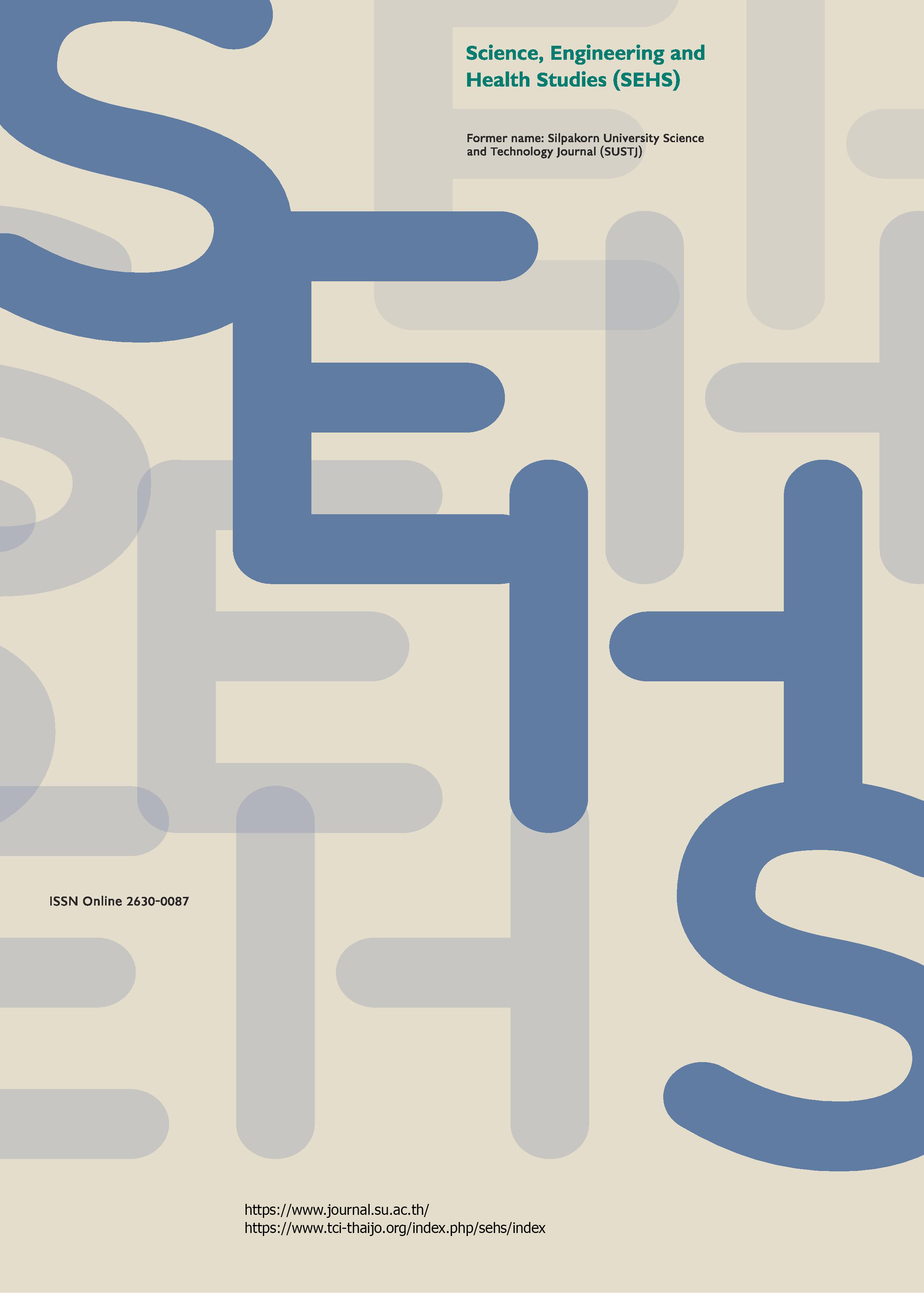Development of mangiferin-loaded anisotropic emulsion for cosmetic applications: A comprehensive study on formulation, antioxidant activity, stability, and skin compatibility
Main Article Content
Abstract
Liquid crystal (LC) emulsions offer a promising system for topical application due to their ability to enhance skin penetration and to improve skin hydration. Mangiferin, a natural polyphenolic compound found in mango leaves, possesses numerous therapeutic properties, including antioxidant and anti-inflammatory effects. This research aimed to develop mangiferin-loaded LC emulsions, focusing on optimizing the formulation, evaluating antioxidation activity, conducting stability tests, and examining skin compatibility. The antioxidant activity was investigated of mangiferin in an aqueous solution and in the developed emulsion against the free radical, 2,2′-diphenyl-2-picrylhydrazyl (DPPH). The developed emulsions containing sorbitan palmitate and sucrose palmitate with a 4:1 ratio displayed an obvious Maltese cross image when observed under polarized light microscopy. The stability results of the developed emulsion containing mangiferin showed that although the mangiferin content, as analyzed by UV absorption, gradually decreased over 90-day study period, its scavenging activity against DPPH radicals remained consistent throughout the study. Furthermore, the mangiferin-loaded emulsion enhanced skin health by increasing water content and reducing transepidermal water loss, without causing any skin irritation.
Downloads
Article Details

This work is licensed under a Creative Commons Attribution-NonCommercial-NoDerivatives 4.0 International License.
References
Acosta, J., Sevilla, I., Salomón, S., Nuevas, L., Romero, A., and Amaro, D. (2016). Determination of mangiferin solubility in solvents used in the biopharmaceutical industry. Journal of Pharmacy & Pharmacognosy Research, 4(2), 49–53.
da Rocha-Filho, P. A., Maruno, M., Ferrari, M., and Topan, J. F. (2016). Liquid crystal formation from sunflower oil: Long term stability studies. Molecules, 21(6), 680.
Eccleston, G. M., Behan-Martin, M. K., Jones, G. R., and Towns-Andrews, E. (2000). Synchrotron X-ray investigations into the lamellar gel phase formed in pharmaceutical creams prepared with cetrimide and fatty alcohols. International Journal of Pharmaceutics, 203(1–2), 127–139.
Ehianeta, T. S., Laval, S., and Yu, B. (2016). Bio- and chemical syntheses of mangiferin and congeners. BioFactors, 42(5), 445–458.
El-Seedi, H. R., El-Barbary, M. A., El-Ghorab, D. M. H., Bohlin, L., Borg-Karlson, A.-K., Göransson, U., and Verpoorte, R. (2010). Recent insights into the biosynthesis and biological activities of natural xanthones. Current Medicinal Chemistry, 17(9), 854–901.
Huang, Y., and Gui, S. (2018). Factors affecting the structure of lyotropic liquid crystals and the correlation between structure and drug diffusion. Royal Society of Chemistry Advance, 8(13), 6978–6987.
Imran, M., Arshad, M. S., Butt, M. S., Kwon, J.-H., Arshad, M. U., and Sultan, M. T. (2017). Mangiferin: A natural miracle bioactive compound against lifestyle related disorders. Lipids in Health and Disease, 16(1), 84.
Jarupinthusophon, S., Preechataninrat, P., and Anurukvorakun, O. (2022). Development of liquid crystal cream containing germinated brown rice. Applied Sciences. 12(21), 11113.
Jutiviboonsuk, A., and Leeprechanon, W. (2019). Stability of mangiferin in lotion and its antioxidant activity. Key Engineering Materials, 819, 79–84.
Liu, Y., and Friberg, S. E. (2009). Role of liquid crystal in the emulsification of a gel emulsion with high internal phase fraction. Journal of Colloid and Interface Science, 340(2), 261–268.
Masibo, M., and He, Q. (2008). Major mango polyphenols and their potential significance to human health. Comprehensive Reviews in Food Science and Food Safety, 7(4), 309–319.
Mishra, B., Priyadarsini, K. I., Sudheerkumar, M., Unnikrishhnan, M. K., and Mohan, H. (2006). Pulse radiolysis studies of mangiferin: A C-glycosyl xanthone isolated from Mangifera indica. Radiation Physics and Chemistry, 75(1), 70–77.
Parveen, R., Akhtar, N., and Mahmood T. (2014). Topical microemulsion containing Punica granatum extract: Its control over skin erythema and melanin in healthy Asian subjects. Advances in Dermatology and Allergology, 31(6), 351–355.
Septianingsih, U. D. A., Reveny, J., and Arianto, A. (2020). Formulation and evaluation of liquid crystal emulsion containing extra virgin olive oil as skin anti-aging. International Journal of Applied Pharmaceutics, 12(4), 85–89.
Sithisarn, P., Rojsanga, P., Sithisarn, P., and Kongkiatpaiboon, S. (2015). Antioxidant activity and antibacterial effects on clinical isolated Streptococcus suis and Staphylococcus intermedius of extracts from several parts of Cladogynos orientalis and their phytochemical screenings. Evidence-Based Complementary and Alternative Medicine, 2015(1), 908242.
Telang, M., Dhulap, S., Mandhare, A., and Hirwani, R. (2013). Therapeutic and cosmetic applications of mangiferin: A patent review. Expert Opinion on Therapeutic Patents, 23(12), 1561–1580.
Tessiri, C., Channarong, S., and Wongtrakul, P. (2021). Development of aqueous formulation containing the extracted mangiferin. Key Engineering Materials, 901, 40–47.
Ueoka, A. R., and Pedriali Moraes, C. A. (2018). Development and stability evaluation of liquid crystal-based formulations containing glycolic plant extracts and nano-actives. Cosmetics, 5(2), 25.
Vilasau, J., Solans, C., Gómez, M. J, Dabrio, J., Mújika-Garai, J. R., and Esquena, J. (2011). Phase behaviour of a mixed ionic/nonionic surfactant system used to prepare stable oil-in-water paraffin emulsions. Colloids and Surfaces A: Physicochemical and Engineering Aspects, 384(1–3), 473–481.
Walker, A. P., Basketter, D. A., Baverel, M, Diembeck, W., Matthies, W., Mougin, D., Paye, M., Röthlisberger, R., and Dupuis, J. (1996). Test guidelines for assessment of skin compatibility of cosmetic finished products in man. Food and Chemical Toxicology, 34(7), 651–660.
Willcox, J. K., Ash, S, L., and Catignani, G. L. (2004). Antioxidants and prevention of chronic disease. Critical Reviews in Food Science and Nutrition, 44(4), 275–295.
Yehia, R. S., and Altwaim, S. A. (2023). An insight into in vitro antioxidant, antimicrobial, cytotoxic, and apoptosis induction potential of Mangiferin, a bioactive compound derived from Mangifera indica. Plants, 12(7), 1539.
Zhang, W., and Liu, L. (2013). Study on the formation and properties of liquid crystal emulsion in cosmetic. Journal of Cosmetics, Dermatological Sciences and Applications, 3(2), 139–144.


